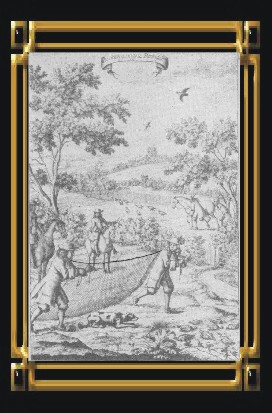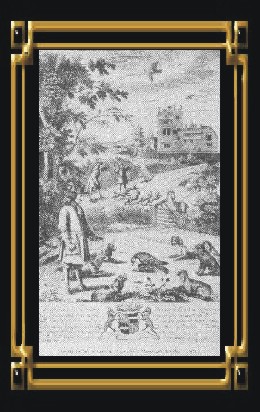Cockers In The Field

GO TO COCKERS IN THE FIELD OF TODAY
GO BACK TO COCKERS IN THE FIELD
COCKERS IN THE FIELD OF YESTERDAY
In the field trials Spaniels are required to cover ground no farther than 30
yards from their master or mistress. They are to find the game, to flush it
and to sit and stay until his master or mistress gives the command to
retrieve the bird on the land or in the water.
In 1864 Mr. John Douglas staged the first officially recognized field trial.
He wrote the rules, invited the judges and put up all the prize money. This
first trial was held on a Tuesday, April 18, 1865, at the Southill,
Bedfordshire Estate of Samuel Whitebread. There were 16 bird dogs that
competed.
The first field trials just for Spaniels were held on January 3 and 4, 1899.
It was sponsored by the Sporting Spaniel Club in England. The President of
the Club didn't care for the performance of the dogs he was quoted as saying,
"All Spaniels were unsteady to shot and wing. All ran mute with the exception
of one puppy."
The second trial held in December of the same year found the Club President
making another comment. "All winners quiet, mute, and too highly trained!"
Centuries ago a Spaniel possessing a musical, but not noisy voice was all the
more valuable if it was distinguishable in it's notes between the various
kinds of game. Today any Spaniel that yips or gives tongue on game in the
field trials will be severely penalized.
The Cocker Spaniel has always been a hunting dog. He is the smallest dog in
the Sporting Group (you will find a list of 26 Breeds in the Sporting Group
on the General Information page). He is a Flushing Spaniel and is a very
active little dog who was bred to go in the field all day.
The first American Kennel Club (AKC) field trial took place in 1925,
organized by the Lady of Rowcliffe, Miss Ella B. Moffit.
The American Spaniel Club held it's first licensed field trial in 1930, there
were 72 entries.
From 1953 to 1962 the American Spaniel Club's Field Trial Committee yearly
held the National Cocker Championship Trials. Since 1963 there had not been a
licensed field trial for Cocker Spaniels because of a loss of interest by the
fancy.
In 1977 the American Spaniel Club began offering Working Tests. Since that
time about 100 or more Cockers have earned Working Test Certificates: WD
(Working Dogs) or WDX ( Working Dog Excellent). Some of the Cockers that
earned the Working Dog titles are Show Champions, some are Obedience titled
and some have both Show and Obedience titles.
In 1983 the Washington State Cocker Spaniel Club tried to revive field trials
when they held the first sanctioned field trial since early 1960. In this
same time period the American Spaniel Club also held Sanctioned B Field
Trials. These events were held twice (2) a year until 1988 when the American
Kennel Club's Hunting Test for all Flushing Spaniels was developed.
The American Spaniel Club hosted the first AKC Hunting Test in History in
combination with the 1988 ASC Summer National held in San Jose, California.
The requirements of the dog was to earn four (4) qualifying scores for the
Junior Hunter (JH), five (5) for the Senior Hunter (SH) and six (6) for the
Master Hunter (MH) titles.
Many books have been written to help you in training a Flushing Spaniel.
Cocker Spaniels hunt in the same way as an English Cocker
Spaniel & English Springer Spaniels.


 In "The Master of Game," based on
Gaston Phoebus's "Livre de Chasse," of 1387, a work written between 1406 and 1413, by
Edward, the second Duke of York, we have the first suggestion that the breed was
Spanish. "Hounds for the hawk, Spaniels, that come from Spain, running and wagging their
tails before their master, raising or starting fowl and wild beasts. How useful they were
for their right craft, which was to act as "crouchers" (setters), helping in this manner to
take both partridges and quail with a net. It was the way game was taken in
those days.
The sportsmen went over
the fields with a net, their hawks up in the air, Keeping the game hiding
close to the ground. The game dared not move lest the hawk should see them.
The Spaniels, on scenting game, turned in the direction in which the game was
hiding. The hawks kept the birds from rising so the dog could get very near
to the game. The Spaniel was trained to go down, while the men placed the net
over him and the birds. If the dog had stood it would have made working the
net difficult.
In "The Master of Game," based on
Gaston Phoebus's "Livre de Chasse," of 1387, a work written between 1406 and 1413, by
Edward, the second Duke of York, we have the first suggestion that the breed was
Spanish. "Hounds for the hawk, Spaniels, that come from Spain, running and wagging their
tails before their master, raising or starting fowl and wild beasts. How useful they were
for their right craft, which was to act as "crouchers" (setters), helping in this manner to
take both partridges and quail with a net. It was the way game was taken in
those days.
The sportsmen went over
the fields with a net, their hawks up in the air, Keeping the game hiding
close to the ground. The game dared not move lest the hawk should see them.
The Spaniels, on scenting game, turned in the direction in which the game was
hiding. The hawks kept the birds from rising so the dog could get very near
to the game. The Spaniel was trained to go down, while the men placed the net
over him and the birds. If the dog had stood it would have made working the
net difficult.
 The First Writing About Dogs
The First Writing About Dogs


Copyright © 1999-2004 CAL-ORE COCKERS
Nancy L. Ray and Lisa L. Ray
All Rights Reserved


 The First Writing About Dogs
The First Writing About Dogs